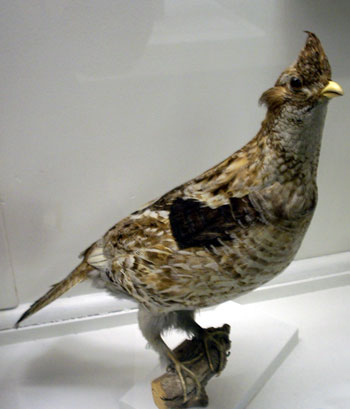
 |
 | |
 | Our founder, Dr. Isaiah Everhart, loved nature and wanted to share all he knew with the people of the Scranton area. And one of the first ways he did that was displaying all the plants and animals of northeastern Pennsylvania. As others joined him - friends, scientists, and volunteers from the community - birds were collected from all over the world. Here's a look at some of them that we think you might not know much about, but are still pretty interesting....  If you didn't know it already, the Ruffed Grouse (not ruffled!) is Pennsylvania's State Bird. This bird got its name from the little tufts of feathers on its upper back. You can see them in the picture to the right - that's right, the flat, dark patch on the side. When this guy tries to attract a mate, the feathers will stand up and spread apart, creating what kind of looks like a ruffle on his back. If you didn't know it already, the Ruffed Grouse (not ruffled!) is Pennsylvania's State Bird. This bird got its name from the little tufts of feathers on its upper back. You can see them in the picture to the right - that's right, the flat, dark patch on the side. When this guy tries to attract a mate, the feathers will stand up and spread apart, creating what kind of looks like a ruffle on his back.Ruffed grouse are not only found in Pennsylvania. They live in forests across the northern United States and throughout Canada. They usually live low to the ground, under shrubs and grasses. This is why you'll often hear them before you see them. Sensing danger, they take to the air with a thunderous whirr. Ruffed Grouse are omnivores, meaning they'll eat plants, berries, and seeds, as well as insects. They've even been known to eat small frogs!   We think this bird is one of the most impressive around, owing to its amazing migration journey. Every year it flies from its Arctic breeding grounds in the north to the Antarctic ice pack in the south in the winter, and then back again. That's nearly 22,000 miles. If you added it up, the average Arctic Tern will travel a distance equal to going to the moon and back during its life! We think this bird is one of the most impressive around, owing to its amazing migration journey. Every year it flies from its Arctic breeding grounds in the north to the Antarctic ice pack in the south in the winter, and then back again. That's nearly 22,000 miles. If you added it up, the average Arctic Tern will travel a distance equal to going to the moon and back during its life!Arctic terns live in large groups of thousands of birds, called colonies. The colony migrates together, taking to the air all at once. Talk about crowded! Usually, terns nest directly on large rocks, and the females lay two to three eggs. Because the eggs are exposed, the adult terns are very protective, attacking whatever enters their territory - even humans! Once hatched, however, most baby terns do not migrate until they are two, and then only with the help of their parents to teach them the way. An Arctic Tern can live as long as 20 years.   Sorry to break it to all you flamingos, but we think the Roseate Spoonbill is the coolest of the pink birds. Just like a flamingo it gets its color from the shrimp it eats. But that beak. What a statement! Sorry to break it to all you flamingos, but we think the Roseate Spoonbill is the coolest of the pink birds. Just like a flamingo it gets its color from the shrimp it eats. But that beak. What a statement!As we're sure you know, the beak does much more than look cool; it also acts as the bird's eyes and hands. Often you'll see the spoonbill quietly wading through the water, beak underwater, its head slowly moving from side to side. Even in the murkiest of water, if the open beak comes across something tasty - a small fish, shrimp, snail, or insect - it clamps down, sifts it from the water, and swallows it. Yum! Back in the the 1800s, the Roseate Spoonbill became endangered. Part of it had to do with more and more people moving into and polluting its habitat (the area where it lives). But more significantly, many birds were killed simply for their feathers, a popular material for women's hats and fans. History has it that early in the 1900s, only a few dozen pairs reamined. But conservationists were able to save it, and the population recovered. Today it is no longer a protected species.   If you thought the Burrowing Owl got its name because of its digging, you'd be wrong - kind of. For the most part, this tiny little long-legged bird seeks out and lives in the homes of other animals like prairie dogs, ground squirrels, and badgers who live in the Plains and the southwestern United States, and South and Central America. But, if conditions are good, it might create a burrow of its own. If you thought the Burrowing Owl got its name because of its digging, you'd be wrong - kind of. For the most part, this tiny little long-legged bird seeks out and lives in the homes of other animals like prairie dogs, ground squirrels, and badgers who live in the Plains and the southwestern United States, and South and Central America. But, if conditions are good, it might create a burrow of its own.Like most owls, the Burrowing Owl is a nocturnal hunter, meaning it looks for prey at night. Meals might include insects like grasshoppers and beetles, or, if its lucky, a mouse or a vole. Not to be picky, however, Burrowing Owls will also eat frogs, toads, salamanders, snakes, small birds, and dead animals. Several techniques are involved in the hunt, including swooping down, hovering and pouncing, and even running. Good thing it's got those long legs!   Unfortunately, you'll never see a Carolina Parakeet except here, stuffed, in the museum. Once spread throughout North America, these colorful little birds went extinct in 1904 (though one lived in captivity until 1918). It was the only parakeet native to the eastern United States. Scientist believe there were several reasons for its extinction. First, like with the Roseate Spoonbill, women loved to use their brightly colored feathers in their hats. Many Carolina Parakeets were also kept as pets. Occasionally, they were eaten as a delicacy. But most significant was the destruction of their environment. As forests were cut down and fields cleared for towns and crops, the birds were forced to eat food where they could find it - oftentimes a farm. Because they would devour an entire harvest, they were seen as a pest. Farmers would kill large numbers of them at a time, made easy because they would flock together to the ground if one had been shot. In the museum's collection, we have three extinct species on display, the Carolina Parakeet, the Passenger Pigeon, and the Ivory-billed Woodpecker. Recently, however, ornithologists have reported sightings of the Ivory-bill, though no definitive proof has been given. To learn more about the debate, check out Cornell University's Lab of Ornithology (www.birds.cornell.edu/ivory/) |